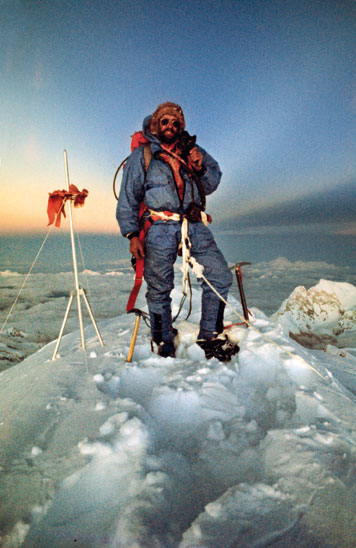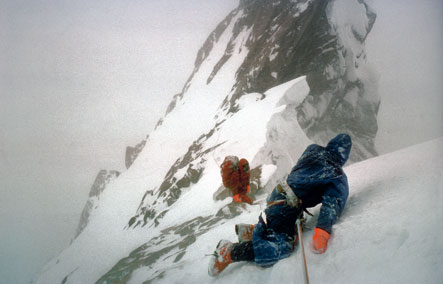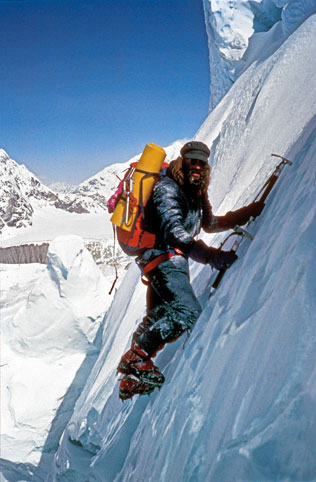


Doug Scott
An Englishman in the Himalayas
His first south-west face of Everest in 1975 made him a âCommander of the Order of the British Empireâ (CBE). The first Englishman to have conquered the roof of the world, Doug Scott is a monument of modern alpinism. Enriched by a career of over 30 expeditions, he now devotes his life to the peoples of the Himalayas.
Words gathered by Vincent Gillioz
Spending a few days in Leysin, Doug Scott, 67 years of age and the first Englishman to have conquered Everest, has agreed to an exclusive interview with Mountain Report. A character from modern alpinism, precursor of the alpine style in the Himalayas, an ardent defender of the living conditions of Sherpas, Doug Scott is much more willing to talk about the ethics of the mountain and the evolution of alpinism than about his career. This specialist of the Big Wall is never lost for words when it comes to speaking about climbing and the equipping of climbing sites. Indeed, a veritable monument of the mountain, Doug Scott displays a disconcerting and typically British modesty and humour.
Doug Scott, how do you regard the evolution of climbing in the Himalayas today given your experience from around thirty expeditions?
If you want to speak about my views on commercial expeditions, which offer all the 8,000 metre summits in their catalogues, it is fairly clear. These climbs all work on the same model, they are designed in such a way that you don’t have to make any decisions, which makes them appeal to a certain public. They tell you when to walk, when and where to sleep, when to eat. Every move you make is taken care of. All you have to do is to fix your ascender to the fixed rope which prevents you from taking any risks, and you follow in the tracks made by the high altitude Sherpas. Sometimes they ask you to have a cup of tea which is prepared for you. If this type of project can give certain people satisfaction, I consider them to be completely devoid of interest. In my view, the value of alpinism lies elsewhere, the decision making is fundamental. Climbing is to judge situations and decide, which aren’t things you find in a commercial expedition.
So it is the context of decision making that you most appreciate about the mountains?
It certainly is! You know, the modern way of life has made us lose any relationship we have with the natural world which surrounds us. None of the decisions you make from day to day will have any real impact on your survival, as was the case for the men thousands of years ago. In this sense, alpinism can be a kind of return to one’s roots. It forces you to take responsibility for your own life. It puts you back in a position where you are faced with the values of our very distant ancestors. When I began climbing in the Alps, what counted for the climbers was not to collect summits, but to open up new routes. I completely adhere to this approach. The important thing was not the speed or the number, but to be the first. I find exploring the unknown fascinating, to look for a passage where nobody has ever been; to interrogate the mountain, to think about how to pass. Today there is practically no opportunity in the Alps left, and this is why the Himalayas are so appealing. There are so many things to do other than 8,000 metre summits.
What is your position as regards resorting to oxygen in the Himalayas?
I don’t blame the oxygen, I have resorted to it several times. However, when we were forced to bivouac just under the summit of Everest in 1975 with Dougal Haston, we had none left. We spent nine hours in a storm at 8,760 m in snow hole and we survived. It is with this type of experience that you learn ultimately that oxygen is not indispensible. I had to get through this episode before giving it up. Each person has to make their own way and learn to know his or her limitations.
What is your relationship with fear when you are in the mountains?
I am from Nottingham, I know no fear!!! (laughs). Joking aside, for me personally it is a question of a feeling you can sense in anticipation, a sort of apprehension prior to tackling the mountains. However, quite frankly, I don’t remember having had to face up to being scared during a climb as you’re much too busy climbing. Even during a fall or when you’re caught in an avalanche, I don’t think I have detected a feeling of this kind. Sometimes, in highly critical moments, I have had the opportunity to briefly take stock of myself, and think about my family again but not in an unpleasant way. I think that the more experience you have of dangerous situations and the more you pass close to death, the more you can tackle other critical moments with a certain hindsight. I was caught up in an avalanche once and I said to myself that I was going to die. I thought about it as a kind of assessment; asking myself how it was going to be, but without fear!
You feel very strongly about equipping the rock walls with bolts (spit), can you tell us more?
Of course! Take Switzerland for example, given that we are here. I can tell you that in this country, there is no longer a rock wall that is not equipped with bolts. The mountain has been transformed into an artificial climbing wall, that is what I think. This matter is much the same as my position on the decision-making aspect of mountaineering. Follow an equipped route, even if it is very difficult, and tell me what remains to be discovered? I think ethics should dictate that climbing sites are not equipped with bolts. The arrival of battery tooling has fostered a kind of pollution of the mountains. Attitudes are very different between the Anglo-Saxons and others in relation to this aspect. In England, there are many sites where you will never see anyone positioning there own pitons and stoppers. Clearly I defend this approach.
Today, you are 100% devoted to the structure that you founded: Community Action Nepal (CAN). What exactly is the purpose of your action?
I started to become interested in the Sherpas’ living conditions in around 1990. The trekking industry has developed exponentially in the Himalayas since the eighties and this development has not always served the Nepalese. My activities on zone prompted me to commit myself to the people of this particularly poor country. A portion of our action consists of ensuring acceptable working conditions for the Sherpas and porters working for the treks, such as a basic social security cover and a minimum of insurance. Via our travel agency, Community Action Treks, we offer tourist stays which integrate our ethical principles. The agency forms only a small part of our action plan. The objective of CAN is to enable rural communities in Nepal to continue to live as they are. We are working to ensure that the villages are not deserted by the young people. For example, in the case of economic migrants heading towards the Middle East, we are putting structures in place to enable the children left behind to continue to live in harmony with their community. I would like to prevent the dream of every inhabitant of Nepal being to migrate to either North America or elsewhere. The goal of our organisation is cultural preservation. We are still building cabins and shelters for Sherpas, who all too often are the victims of weather conditions due to a lack of appropriate equipment. CAN’s action plan is comprehensive and we also have environmental concerns. I invite you to visit our website and to take heed of our work if you have to travel to Nepal.
www.canepal.org.uk
Read the rest of the article in the Mountain Report magazine - Where to find ?


